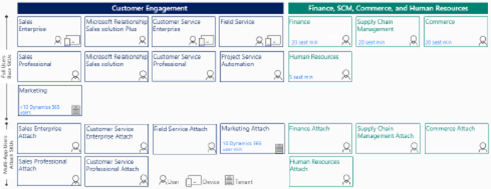No two ways about it. It is not straight forward to know which Finance solution from Microsoft you should go for by reading the information on Microsoft’s web site.
Microsoft Dynamics 365 Business Central does finance as does Dynamics 365 Finance (the names do not help things here either!).
Both solutions are:
- an excellent choice for your finance team
- cloud-based
- extendable with access to 3 rd party Apps
- customisable to help make them fit the way you want to work
- integrated to Microsoft (Office) 365, other Dynamics 365 products and the Microsoft “Power Suite”
So, which is the right one for you and your business?
An excellent way to start this journey is to state how Microsoft sees these two solutions.
Microsoft Description
The below descriptions are from Microsoft’s web site.
Business Central
Run your entire business with a single solution
Streamline your processes, make smarter decisions, and accelerate growth with Dynamics 365 Business Central—a comprehensive business management solution designed for small to medium-sized businesses.
Finance
Maximise financial visibility and profitability
Automate and modernise your global financial operations with Dynamics 365 Finance. Monitor performance in real-time, predict future outcomes and make data-driven decisions to drive business growth.
In many ways what they both say can be attributed to both products (except the “all in one” element of Business Central).
The clearest differentiator is that Finance is just for finance, whereas Business Central covers many more bases. However, they both can be used as finance only solutions.
One other clear differentiation is the cost of these two solutions. This difference alone may be enough to decide for you.
After this, things get increasingly nuanced, and there is a ‘blurring of the lines’ between then. Anyway, we like a challenge here at Cbiz, so let’s get going…
Prices & Users
Info
Full User
Per User Per Month
Team Member User
Prices are correct as of 1 July 20
Business Central
Essentials – £52.80
Premium – £75.40
£6
1
Finance
£135.70
As a finance system, there is clear air between the two based on price. And that is before you consider Business Central does way more than just finance.
The pricing structure means it costs from £ 52.80 to get started with Business Central, as a single user system for Essentials (what most businesses will need). Whereas for Finance, the starting point is £2,714 per month. To give a more direct comparison, a 20 user Business Central system would be £ 1,056 per month.
This price structure / minimum user count implies that Finance is there to suit the larger, more enterprise-class business customers. However, that is only partly true as Business Central also has many installations in larger companies, spanning hundreds of users.
Functionality
While Business Central has a Finance module at its core, it extends to other departments/areas in a business and is an ‘all in one’ solution.
On the other hand, Finance is aimed squarely at a Finance team. To extend the Finance solution to other areas of the business, you need to separately license & implement Dynamics 365 Sales, Supply Chain Management, etc.
Finance, together with Supply Chain, Sales, Customer Service, etc. will provide a deeper set of functionalities than Business Central, along with the need for much deeper pockets.
Business Central meets most of the requirements a business needs from its software. The additional features – if required – can then be matched with fully integrated Apps & customisations. Which also tend to be offered at a cheaper price point (when compared to Finance).
Licence Complexity
The difference in complexity between these two starts with working out how to License them. Business Central is far more straightforward as there are fewer choices to make.
Business Central
You decide if you need the additional features of the Premium solution, if not, then Essentials is the one you want. Then you choose how many users you need. The full users can – subject to permissions – edit, create and transact what they want. Team Members are read-only or with light editing.
You buy the license from a Cloud Solution Provider, typically via your partner.
Note that the other choice you have is if you want this solution on subscription (on the cloud) or to pay for it upfront and have it on your servers.

(Image is from the Dynamics 365 Business Central Licensing Guide – May 2020)
The full guide is here Microsoft Dynamics 365 Business Central download.
Finance
Finance starts with a minimum number of 20 users. How you buy them depends on what is best for your business and if you have Volume Licensing agreements with Microsoft, or you can buy from Cloud Solution Providers or Web Direct programs.
Volume Licenses are agreements typically held with larger organisations and affect the way you license products from Microsoft and the price paid.
The price for Finance also depends on it being your ‘base’ product from the Dynamics 365 stack or not. If you have already got a Business Application (like Dynamics 365 Sales, Dynamics 365 Customer Service, etc.), then you can buy Finance as an ‘Attach’ license, which may come at a lower price.

(Image is from the Dynamics 365 Licensing Guide – June 2020)
The full guide can be found from the Microsoft Dynamics 365 Finance download link.
Implementation
A significant factor in choosing is the speed at which these solutions can be implemented. Business Central projects are more aligned to speed & flexibility; whereas Finance ones are typically longer and require more complexity and usually a bigger (more expensive) team.
Broadly, the daily rate of Finance consultants is higher than those in Business Central. Both have a wide choice of partners, so there is a spread of prices that are charged for these solutions.
Business Central finance projects can be discussed in days or weeks, depending on what your business requires. It can start small with a templated setup and grow to be a richer solution across more business areas over time.
It can be extended with off the shelf Apps or with specific tailoring for your business. Customisations are done in a separate language called AL that has been created specifically to meet business requirements and handle transaction processing.
The roots of this language go back to the early 1980s and are based on tried and trusted ways to meet unique business requirements. This first language has been significantly modernised to allow for seamless upgrades and better control.
Finance implementations are typically discussed in weeks and months. The setup is more complex and is aligned with a team that knows what they need. With formally agreed specifications required at the start. While this is broadly true of any implementation (including those with Business Central) the impact of additional costs when changing direction is higher with Finance.
Meeting Multi-national requirements
A ‘headline’ different between Business Central and Finance is how they approach a solution for multi-national companies.
Business Central and Finance are both used by international corporations. The solution that works better for you depends mainly on your preference in providing:
- a single solution that all companies work in; or
- a set of local solutions that work together with the group.
Finance allows for a single solution. You define how you want the individual businesses to work and deploy that centrally. Local companies have some say in ‘following their own path’, but typically this is a head office controlled solution.
The individual companies either work with a ‘centre of excellence’ within the head office and / or with a global partner.
International Business Central solutions tended to follow a ‘hub and spoke’ approach. A core, convenient way of working is agreed – and customised if required – and then deployed to the local businesses. The local companies are then freer to follow their path to ensure the system works for them as well.
This could all be handled in a ‘centre of excellence’ at head office, with a head office ‘lead’ partner and/or with local companies working with local partners.
We hope that this has helped you understand some of the differences between these two systems and has nudged you down the route of choosing one over the other: and for the right reasons.



